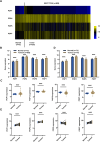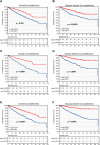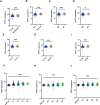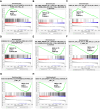Prognostic Value and Immunological Role of POP7 in Clear Cell Renal Cell Carcinoma
- PMID: 39620194
- PMCID: PMC11608043
- DOI: 10.2147/PGPM.S469247
Prognostic Value and Immunological Role of POP7 in Clear Cell Renal Cell Carcinoma
Abstract
Background: Studies have found that RNA-binding proteins (RBPs) are participated in the occurrence or development of tumours. However, the role of processing of precursor family (POP family) in clear cell renal cell carcinoma (ccRCC) has not been studied yet. Here, we analyzed the expression and prognostic value of POP family in ccRCC analyzed and subsequently revealed the relationship between POP7 and immune infiltration in ccRCC patients.
Methods: POP family expression in cancer and normal tissues was analyzed in Cancer Genome Atlas pan-cancer (TCGA-pan-cancer). Kaplan-Meier (KM) survival analysis, univariable and multivariable analysis demonstrated the survival of ccRCC with POP family in Kidney Clear Cell Carcinoma (TCGA-KIRC). POP7 mRNA and protein expression were verified by Gene Expression Omnibus (GEO) data, the quantitative real-time polymerase chain reaction (qRT-PCR), and Office of Cancer Clinical Proteomics Research (CPTAC). The diagnostic ability of POP7 mRNA and protein expression was achieved with ROC curves. Gene Set Enrichment Analysis (GSEA) and TiMER2 evaluated pathogenesis role and immune infiltration of POP7in ccRCC.
Results: There is a significant difference in expression of POP family in TCGA-pan-cancer, especially in ccRCC. KM survival analysis, univariable and multivariable analysis demonstrated low expression of POP7 and was associated with poor OS and poor DFS. GEO data, the qRT-PCR, and CPTAC verified the high expression of POP7 mRNA and protein in ccRCC. ROC curves verified a valuable diagnostic ability of POP7 in mRNA and protein expression. GSEA demonstrated POP7 was associated with CD8+cells, CD4+cells, natural killer (NK) cells, and helper T (TH1) cells. TiMER2 results indicated POP7 had a positive correlation with T cell regulatory (Tregs) and myeloid-derived suppressor cells (MDSC) in ccRCC and was an immunosuppressor for ccRCC.
Conclusion: POP7 was a reliable immunosuppressor, predictor and biomarker for ccRCC.
Keywords: POP7; ccRCC; immunotherapy; prognostic indicator.
© 2024 Lou et al.
Conflict of interest statement
The authors report no conflicts of interest in this work.
Figures







Similar articles
-
High Expression of DNTTIP1 Predicts Poor Prognosis in Clear Cell Renal Cell Carcinoma.Pharmgenomics Pers Med. 2023 Jan 6;16:1-14. doi: 10.2147/PGPM.S382843. eCollection 2023. Pharmgenomics Pers Med. 2023. PMID: 36636625 Free PMC article.
-
FUT10 is related to the poor prognosis and immune infiltration in clear cell renal cell carcinoma.Transl Cancer Res. 2025 Feb 28;14(2):827-842. doi: 10.21037/tcr-24-449. Epub 2025 Feb 26. Transl Cancer Res. 2025. PMID: 40104704 Free PMC article.
-
The Downregulation of Prognosis- and Immune Infiltration-Related Gene CYFIP2 Serves as a Novel Target in ccRCC.Int J Gen Med. 2021 Oct 11;14:6587-6599. doi: 10.2147/IJGM.S335713. eCollection 2021. Int J Gen Med. 2021. PMID: 34703279 Free PMC article.
-
Upregulated GSDMB in Clear Cell Renal Cell Carcinoma Is Associated with Immune Infiltrates and Poor Prognosis.J Immunol Res. 2021 Dec 16;2021:7753553. doi: 10.1155/2021/7753553. eCollection 2021. J Immunol Res. 2021. PMID: 34957313 Free PMC article.
-
A comprehensive analysis of the prognostic value and immune infiltration of low expression DBT in clear cell renal cell carcinoma.Front Pharmacol. 2022 Oct 10;13:1002588. doi: 10.3389/fphar.2022.1002588. eCollection 2022. Front Pharmacol. 2022. PMID: 36299888 Free PMC article.
References
-
- Ishiyama Y, Omae K, Kondo T, Yoshida K, Iizuka J, Takagi T. Predicting recurrence after radical surgery for high-risk renal cell carcinoma: development and internal validation of the TOWARDS. Score Annals of Surgical Oncology. 2024;2024. - PubMed
LinkOut - more resources
Full Text Sources
Research Materials
Miscellaneous

